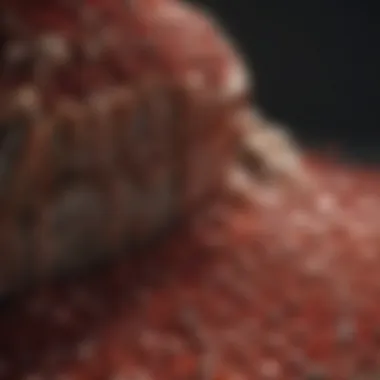Exploring Blood and Bone Garden Fertiliser


Intro
Blood and bone fertiliser is a significant component in the world of gardening and agriculture. It offers a natural way to enhance soil fertility and provide essential nutrients to plants. Understanding its composition and usage is critical for anyone looking to foster healthy growth in their gardens or farms. This article will cover the key aspects of blood and bone fertiliser, offering insights into its origins, benefits, application techniques, and sustainable practices.
Gardening and farming are foundational activities for many cultures. As the demand for sustainable practices grows, natural fertilisers like blood and bone are becoming more popular. This article caters to both amateur gardeners and seasoned agricultural enthusiasts, empowering them with knowledge that promotes informed decisions in their cultivation processes.
Key Concepts and Terminology
Basic Definitions
Blood and bone fertiliser is primarily composed of animal by-products. Blood meal provides a high nitrogen content, crucial for leaf and stem development. Bone meal contributes phosphorus and calcium, vital for root health and flowering. These nutrients are released slowly into the soil, facilitating long-term plant growth.
Historical Context
Historically, blood and bone fertilisers have been used for centuries. Ancient cultures utilized animal remains as natural fertilisers in agriculture. Over time, as agricultural practices evolved, the methods for processing and applying these natural products became more refined. Today, laboratories create these fertilisers to meet exact standards, ensuring safety and efficacy.
Recent Innovations and Trends
Technological Advancements
Modern innovations in fertiliser production focus on optimising nutrient release and improving the overall quality of blood and bone fertiliser. Advanced methods include controlled-release formulations that enhance nutrient uptake by plants while minimizing waste.
Sustainable Practices
Incorporating blood and bone fertiliser into agricultural practices aligns with sustainable gardening principles. Using animal by-products reduces waste and promotes recycling within ecosystems. This practice encourages biodiversity and supports healthier soil conditions, ultimately benefiting both the environment and crop yields.
Practical Applications and Techniques
Step-by-step Guides
Using blood and bone fertiliser effectively involves several steps:
- Soil Testing: Evaluate soil nutrient levels to determine if blood and bone is needed.
- Application: Spread the fertiliser evenly over the soil before planting or during the growing season.
- Watering: Ensure adequate moisture to help activate the nutrients and facilitate absorption by plants.
- Monitoring: Keep an eye on plant growth and adjust fertilisation practices as needed.
Case Studies
Many gardeners have experienced success with blood and bone fertiliser. For example, local community gardens have reported increased yields when integrating this fertiliser into their soil management practices. By combining blood and bone with organic compost, these gardens enhance nutrient availability and overall soil health.
"Blood and bone fertiliser not only supports plant growth but also enriches the soil ecosystem."
Prelims to Blood and Bone Fertiliser
Blood and bone fertiliser is a traditional gardening choice, valued for its natural composition and effectiveness in boosting plant vitality. Understanding blood and bone fertiliser is crucial for both amateur gardeners and seasoned agricultural professionals. Its organic elements offer a gentle yet powerful approach to improving soil quality. This section aims to introduce the concept, its benefits, and important considerations concerning its use in horticulture.
Definition and Overview
Blood and bone fertiliser is an organic soil amendment derived from animal by-products, typically blood and bones. This fertiliser provides essential nutrients that contribute to better plant growth. The nutrient-rich ingredients act as a slow-release source of nitrogen and phosphorus, which are vital for healthy plant development. In contrast to synthetic fertilisers, blood and bone ingredients create a balanced nutrient supply without the risk of chemical burn to plant roots.
In practice, this means that blood and bone fertiliser supports robust soil health, encouraging earthworm activity and microbial life. This living ecosystem allows for better nutrient absorption by plants while promoting long-term sustainability.
Historical Use in Agriculture
Historically, blood and bone fertiliser has been employed in agriculture for centuries. Its origins can be traced back to ancient civilizations, where animal remains were used to enhance soil fertility. Farmers have adapted this practice based on local availability of animal by-products and varying market needs. In many cultures, using such organic matter was common as both a practical solution and a method to nurture crops.
The industrial revolution brought changes to agriculture, introducing synthetic fertilisers that quickly gained popularity due to their efficiency. However, the trend towards organic farming has rekindled interest in blood and bone fertiliser, as sustainability and environmental impact are now priority concerns for many growers. By reverting to these historical practices, modern farmers can ensure they restore balance in their agricultural systems.


Composition of Blood and Bone Fertiliser
Understanding the composition of blood and bone fertiliser is crucial for making informed choices in gardening and agriculture. The primary ingredients, blood meal and bone meal, each contribute distinct nutrients essential for plant health. By delving into the nutritional profile, gardeners can assess how these components can enhance soil quality and plant growth.
Primary Ingredients
Blood Meal
Blood meal stands out as a rich source of nitrogen. This organic fertiliser is derived from animal blood, typically collected from abattoirs. Its high nitrogen content supports plant growth, as nitrogen is a key macronutrient necessary for leaf development and overall vitality. Notably, blood meal is often considered a fast-acting fertiliser. This attribute means that plants can quickly absorb the nitrogen, leading to immediate visual improvements in growth.
However, blood meal does come with certain considerations. The presence of such concentrated nitrogen can lead to nutrient imbalance if not used judiciously. It is crucial for gardeners to monitor nitrogen levels in the soil to avoid potential toxicity to plants. Furthermore, the application should be tailored based on plant requirements and soil conditions to ensure optimal benefits without adverse effects.
Bone Meal
Bone meal, on the other hand, provides a strong source of phosphorus and calcium. It is produced by grinding animal bones into a fine powder. Phosphorus is essential for root development and flowering, making bone meal particularly advantageous for early-stage plant growth and flowering plants. The calcium content also promotes healthy cell wall structure, which contributes to overall plant strength and resilience.
The unique feature of bone meal is its slow-release nature. This slow release ensures that nutrients are available to plants over an extended period, reducing the need for frequent applications. However, bone meal may not be as immediately effective as blood meal, requiring a period for plants to access the nutrients. Additionally, as with blood meal, understanding soil nutrient profiles helps to avoid excess applications, which can lead to nutrient lockout.
Nutritional Profile
Macronutrients
The macronutrient profile of blood and bone fertiliser primarily includes nitrogen from blood meal and phosphorus and calcium from bone meal. The balance of these nutrients is vital to ensure plants receive the necessary elements for robust growth. The nutrient value is reflected in the N-P-K ratios listed on product labels, with blood and bone often differing in function based on their primary macronutrient focus.
In addition to their distinct characteristics, the integration of these macronutrients supports various growth stages of plants, facilitating everything from seedling establishment to flowering and fruiting. This holistic approach ensures that gardeners have a comprehensive fertilising strategy that aligns with their specific gardening goals.
Micronutrients
Beyond the primary macronutrients, blood and bone fertiliser also contains several essential micronutrients. These include iron, zinc, and copper, which are critical for various physiological functions within the plant. For instance, iron is necessary for chlorophyll production, while zinc plays a role in enzyme activity important for growth.
The inclusion of these micronutrients is an important aspect that enhances the overall effectiveness of blood and bone fertiliser. While often overlooked, these trace elements can significantly affect plant health and vigour. Understanding the specific micronutrient needs of different plants can guide gardeners in applying blood and bone fertiliser, ensuring that their plants thrive.
Benefits of Using Blood and Bone Fertiliser
Blood and bone fertiliser offers various advantages for gardening and agricultural practices. Understanding these benefits is essential for gardeners looking to improve soil quality and promote better plant health. Blood and bone fertiliser is not only an organic solution for nutrient delivery but also aligns with sustainable gardening principles. The use of this fertiliser can transform the fertility of soil, leading to a flourishing garden.
Improved Soil Health
One of the primary benefits of blood and bone fertiliser is its positive impact on soil health. The organic components contained in this fertiliser enhance the biological activity within the soil. Microorganisms such as bacteria and fungi thrive, which helps in breaking down organic matter. This process results in better soil structure and aeration.
Additionally, using blood and bone fertiliser increases the organic matter in soil, promoting moisture retention. This is particularly important in agricultural settings, where water conservation can lead to significant cost savings. It leads to an enhanced nutrient-cycling capacity, fostering a balanced ecosystem in the soil.
Enhanced Plant Growth
The nutrient-rich profile of blood and bone fertiliser contributes significantly to improved plant growth. Blood meal is a source of nitrogen, which promotes vigorous leaf development and overall plant vigor. On the other hand, bone meal is rich in phosphorus and calcium, crucial for root development and flowering. These nutrients are essential at various growth stages of plants.
In this context, the balanced nutrient ratio provided by blood and bone fertiliser supports the growth of fruits and vegetables. As a result, gardeners often report higher yields and improved quality of produce when they integrate this fertiliser into their gardening routines.
Sustainable Gardening Practices
Incorporating blood and bone fertiliser into gardening practices aligns with principles of sustainability. This fertiliser minimizes reliance on synthetic options, promoting an organic approach to gardening. The materials used in its production are often by-products from the meat industry, reducing waste.
Furthermore, using organic fertilisers such as blood and bone not only nurtures the soil but also safeguards the surrounding environment. Since it is less likely to leach into waterways, it poses a reduced risk of water pollution compared to chemical alternatives.
"Sustainable practices in gardening contribute not only to better plant health but also to a healthier ecosystem."


In summary, the benefits of blood and bone fertiliser include nutrient-rich contributions to soil and enhanced plant growth, all while embracing sustainable gardening practices. This makes it an ideal choice for both amateur and professional gardeners dedicated to excellence in horticulture.
Application Methods
The application methods for blood and bone fertiliser play a critical role in its effectiveness and overall impact on soil and plant health. Understanding the right techniques can enhance nutrient availability to plants while ensuring sustainable gardening practices. Proper application methods also mitigate potential drawbacks of overuse or nutrient imbalance, making this information vital for any gardener or agricultural enthusiast.
Preparation Techniques
Before applying blood and bone fertiliser, it is essential to prepare the garden bed or soil adequately. This involves several steps:
- Soil Testing: Conduct a soil test to determine existing nutrient levels and pH balance. This helps in identifying the right quantity of fertiliser required.
- Clearing Debris: Remove any debris, weeds, or dead plant material from the area. This ensures that the fertiliser can directly reach the soil without obstruction.
- Mixing with Soil: When applying, it is recommended to mix the fertiliser well into the top layer of soil. This aids in a more uniform nutrient distribution and reduces the risk of nutrient runoff.
- Watering: After application, light watering can help activate the fertiliser and promote its integration into the soil. Avoid heavy watering, as it can wash away nutrients before they can be absorbed by plants.
These preparation techniques enhance the efficiency of blood and bone fertiliser, leading to healthier plants and improved garden yields.
Application Timing
Timing is a crucial factor in the successful application of blood and bone fertiliser. Correct timing ensures maximum nutrient uptake by the plants and helps avoid periods when plants may not require additional feeding.
Seasonal Considerations
Seasonal considerations involve understanding the optimal times during the growing season to apply fertiliser. Generally speaking, the early spring is often the most beneficial time for application. During this period, plants are awakening from dormancy and actively seeking nutrients to support their growth. Applying blood and bone fertiliser at this time can lead to:
- Enhanced Growth: Nutrient availability aligns with the natural growth period, allowing plants to thrive.
- Root Development: Improved nutrient uptake can support strong root systems, especially for young plants.
The unique feature of seasonal application is that it coincides with plant life cycles, maximizing the advantages of blood and bone fertiliser. However, applying too late in the season can lead to nutrient wastage, as plants may not utilize them effectively before the onset of colder weather.
Frequency of Application
Frequency of application is another key consideration. Blood and bone fertiliser generally does not need to be applied as frequently as synthetic options. Most gardeners find that applying it two to three times yearly suffices. The primary reasons for this moderate frequency include:
- Slow Release of Nutrients: Unlike synthetic fertilisers, blood and bone products release their nutrients gradually, reducing the need for frequent applications.
- Soil Health: Over-fertilising can lead to nutrient leaching and can disturb soil microbiota, which are essential for healthy soil ecosystems.
The unique feature of this frequency is that it supports sustainable gardening practices. By spacing out applications, gardeners can maintain a balanced ecosystem while still fostering plant health. Neglecting this can lead to either nutrient deficiency or excess, both of which can harm plant growth.
Overall, careful consideration of application methods, preparation techniques, and timing will maximize the benefits of blood and bone fertiliser. This will ensure optimal soil health and contribute to successful gardening outcomes.
Considerations for Application
When it comes to using blood and bone garden fertiliser, understanding the considerations for application is crucial. This product has specific characteristics that affect its performance. Proper application can maximize its benefits while minimizing potential drawbacks. Thus, two main aspects must be examined: soil testing and compatibility with other fertilisers.
Soil Testing
Soil testing is often overlooked but is an essential step before applying any fertiliser, including blood and bone. By testing the soil, gardeners can determine its nutrient levels, pH, and organic matter content. Such information is important for a few reasons:
- Nutrient Requirements: Knowing existing nutrient levels helps in deciding how much blood and bone fertiliser to apply. This prevents over-fertilisation, which can harm plants and the environment.
- pH Levels: The pH level of soil influences nutrient availability. Blood and bone typically works well in a slightly acidic to neutral pH range (6.0 - 7.0). A soil test will inform if amendments are needed to adjust pH before application.
"Regular soil testing can save time and resources by ensuring the right nutrients are applied at the right time."
- Microbial Activity: Healthy soil should have a diverse range of microorganisms. A soil test can show if the levels of organic matter are sufficient to promote microbial life, which is essential for breaking down the nutrients found in blood and bone fertiliser.
Compatibility with Other Fertilisers
Understanding how blood and bone fertiliser interacts with other fertilisers is also necessary for effective gardening. While it can be used alone, it can also be combined with other products to enhance soil and plant health. Here are some considerations regarding compatibility:
- Synergy: Some fertilisers may complement blood and bone by supplying nutrients that it lacks. For example, combining it with a fertiliser high in potassium can provide a more balanced nutrient profile.
- Application Timing: Different fertilisers may require varying application methods or timings. For instance, it may be appropriate to apply blood and bone fertiliser during the growing season, while another may require application during dormancy. Planning these applications can optimize nutrient uptake.
- Potential Competition: Care must be taken when mixing products. Some synthetic fertilisers can lead to a nutrient imbalance when combined with organic fertilisers. A mixed approach should consider the specific nutrient content and needs of the plants.


In summary, attention to soil testing and compatibility with other fertilisers enhances the efficacy of blood and bone fertiliser. Specific tests and a clear understanding of other products create a more harmonious growing environment.
Potential Drawbacks
Understanding the potential drawbacks of blood and bone fertiliser is essential for informed gardening and agricultural practices. While it has numerous benefits, like enhancing soil health and promoting vibrant plant growth, there are some considerations that cannot be overlooked. Gardners should assess these drawbacks to make educated decisions.
Nutrient Imbalance
Nutrient imbalance can occur when blood and bone fertiliser is used without proper soil testing. This fertiliser is rich in nitrogen, phosphorus, and other elements. Applying too much can lead to an excess of these nutrients. This nutrient surplus can disrupt the growth of plants, leading to poor health or even death in extreme cases. Plants need a balanced mix of nutrients, and an excess of one can inhibit the uptake of others, creating an unhealthy growing environment. Therefore, regular soil testing is crucial before application. It helps to ascertain pre-existing nutrient levels, ensuring that the addition of blood and bone fertiliser does not skew the balance unfavorably.
Environmental Concerns
Comparative Analysis with Synthetic Fertilisers
The discussion of blood and bone fertiliser cannot be complete without a thorough comparison with synthetic fertilisers. Both types of fertilisers have a significant place in agriculture, each bringing its unique advantages and challenges. It is vital for farmers and gardening enthusiasts to understand these differences, as it shapes their choices regarding soil management and plant nutrition strategies.
Nutrient Delivery Mechanisms
One core aspect of this comparison lies in how the nutrients are delivered to the plants. Blood and bone fertilisers provide slow-release nutrition, where nutrients are released gradually as the organic materials break down over time. This mechanism not only helps in ensuring a steady supply of nitrogen and phosphorus but also supports beneficial microbial activity in the soil.
In contrast, synthetic fertilisers often use soluble nutrients, which can be readily absorbed by plants. This can lead to quick results in terms of plant growth and health. However, the rapid absorption can also create problems, such as nutrient leaching into water systems, leading to pollution and diminishing soil quality over time. Moreover, the excess nutrients can cause imbalances in soil pH, adversely affecting overall soil health.
"Using blood and bone fertiliser promotes a healthier soil ecosystem, fostering long-term sustainability."
While synthetic options can seem appealing for immediate results, the longer-term benefits of organic fertilisers like blood and bone cannot be overlooked. The choice between synthetic and organic must reflect environmental considerations and responsible farming practices.
Long-term Soil Effects
This leads us to examine the long-term effects of these two fertiliser types on soil health. Continuous use of synthetic fertilisers may lead to the degradation of soil structure and biodiversity. Over time, the reliance on chemical inputs can diminish the organic matter content in the soil, reducing its resilience and fertility.
On the other hand, blood and bone fertiliser enriches the soil with organic matter. This promotes enhanced soil structure, increased moisture retention, and improved nutrient cycling. The nutrients from the organic fertiliser become more available for future crop cycles, because they encourage earthworm activity and other beneficial organisms. This results in a more robust ecosystem that is better equipped to handle environmental stresses.
Both short-term and long-term effects matter, so farmers and gardeners must weigh their options carefully. By analyzing these factors, it becomes clearer that while synthetic fertilisers may provide quick fixes, blood and bone fertiliser supports more sustainable agricultural practices.
Understanding the implications of each choice will enable informed decision-making that benefits both the plants and the wider ecosystem.
Culmination
The conclusion of this article emphasizes the significance of blood and bone garden fertiliser in contemporary gardening and agricultural practices. By providing a natural source of essential nutrients, it supports sustainable methodologies that appeal to both amateur gardeners and seasoned agriculturalists. The multifaceted benefits spanning soil health, plant growth, and environmental consciousness serve as core arguments for its use.
Summary of Key Points
- Blood and bone fertiliser contains valuable macronutrients and micronutrients beneficial for soil and plant health.
- Applications of this fertiliser can improve soil structure and fertility.
- Its natural composition aligns with sustainable gardening practices, making it an appealing option for eco-conscious gardeners.
- The potential drawbacks, like nutrient imbalance and environmental concerns, necessitate careful application and soil testing.
- Comparing blood and bone fertiliser with synthetic alternatives reveals its long-term advantages for soil health and nutrient retention.
Final Recommendations
For optimal results with blood and bone fertiliser, consider the following recommendations:
- Conduct soil testing prior to application to determine nutrient needs.
- Apply at appropriate times, focusing on growing seasons to enhance plant uptake.
- Avoid over-application to prevent nutrient runoff and imbalance.
- Consider integrating blood and bone fertiliser with other organic practices for holistic soil health.
Adopting blood and bone fertiliser can greatly contribute to a sustainable garden while equipping gardeners with the knowledge necessary for successful cultivation.
Importance of References
- Credibility: References establish the validity of the content. Citing reputable sources such as scientific journals, agricultural studies, and expert opinions is essential. This not only assures the reader about the reliability of the information but also supports the argument for using blood and bone fertiliser based on evidenced benefits.
- Depth of Understanding: Providing references allows readers to explore topics in greater detail. For instance, those interested in specific nutritional profiles can consult detailed studies and research papers linked in the references. This promotes a deeper understanding of how blood and bone fertilisers contribute to soil health and plant growth.
- Encouragement for Further Research: Including various references encourages readers to conduct their own research. This self-directed exploration is valuable for both novice gardeners and seasoned agricultural professionals looking to enhance their practices. The references act as a roadmap for discovering more about the subject.
Specific Elements of References
- Scholarly Articles: Many of the claims regarding the effectiveness of blood and bone fertilisers are backed by peer-reviewed research. Citing these articles informs the reader about the scientific studies that inform agricultural practices.
- Agricultural Manuals: These texts often offer practical guidance. References to them can enhance the practical aspect of using fertilisers in real-world gardening scenarios.
- Online Resources: Websites like Wikipedia and Britannica provide accessible information that is frequently updated. Linking to these can help readers gather basic knowledge quickly.
End
In summary, references are not merely supplementary; they are integral to the understanding of blood and bone fertiliser. They provide verification, guidance, and pathways to additional information that enrich the reader's experience. By integrating carefully chosen references, this article aims to offer a well-rounded perspective on blood and bone fertilisation, encouraging informed usage in gardening and agriculture.















